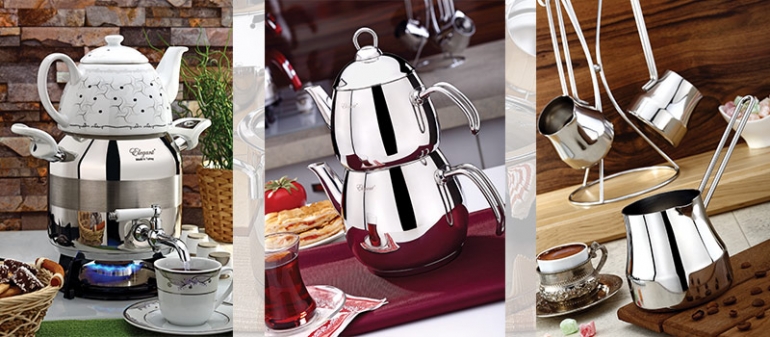Guarantee Specifications
- Homepage
- Customer Service
- Guarantee Specifications
Arzu Celik Cookware features a super thick “tri-ply” thermal diffusion base. Consequently, you will need to setting.
The most common cause of complaint is due to aspiring cooks cooking on too high a heat. A lower heat setting will result in better cooking performance, increased retention of Waterless Cooking of vegetables
*Place rinsed ingredients (vegetables, dripping wet or cold pan. Fill pot ¾ Tbs. with ingredients.
*Heat at medium high setting until the first trace of steam begins to escape from the lid. Reduce heat and cook on a low setting.
*If steam is escaping from the lid after heat has been reduced, reduce heat to the lowest setting. If necessary, briefly remove the pan from the heat source or turn stove off for a short time to prevent over cooking or burning.
*Do not season the food until the cooking process is completed. The natural vitamins, flavors and mineral salts are retained inside the food.
*Cooking times for vegetables are highly variable and are comparable to those required for conventional stovetop cooking.
*If the lid is repeatedly removed, add a little water to compensate for the loss. (2-3 Tbs.)
*The perfect cooking temperature (stove setting) is achieved when just a little steam escapes around the rim. If the temperature is too high, lots of steam will be escaping.
If the temperature is too low, turn up the heat slightly.
Cookware Care Instructions
Common Cleaning Queries Answered
Why does my stockpot / tava discolorand my roti’s stick?
To avoid sticking and discoloration, drop the stove heat. Your stockpot/tava should NOT be used on high heat. To clean any stubborn burnt oil/ ghee marks, spray with Zeb oven cleaner and place in a plastic bag. Remove after a while and clean tava.
Routine cleaning of the Tava involves filling with water while still warm and using Sunlight liquid or a teaspoon of lemon juice.
The base of my post are black. What can I do?
Use any Oven Cleaner. See details as given for Stockpot/Tava above. Oven Cleaner can also be used for burnt food deposits.
Why are my Ovenprufe post a “golden” colour?
Any Stainless Steel will discolour at high heat. To reduce dicolouration, ensure the ffg:
- Oven Thermostat is not faulty
- Pot has sufficient quantity of food in it
- Pot is not too close to ovent element.
NB. The dicolouration is not Rust. It is purely a cosmetic/aesthetlc discolouratlon caused by the accelerated oxidatlon of chromium in the steel. It will not affect the performance or the pot.
Routine Cleaning
Stainless Steel’s best friends are quite simply soap, or mild detergent, or dilute ammonia in warm water applied with a soft cloth or synthetic sponge. Rinse well and dry with a soft cloth.
Occasionally the use of a mild household cleaner (eg. Handy Andy), a fine synthetic scourer (green “Scotch Brite”) or a brush with nylon bristles may be used. Routine cleaning applied repeatedly ove several days will often remove heavy soiling and staining which has occurred will become less noticeable (may even completely disappear).
Do’s
*Routine simple and gentle cleaning
*Use cleaners showing “Suitable for Stainless Steel”
*Rub in direction of finish
*Repeated routine cleaning rather than affressive single cleaning
Don’ts
*Do NOT place empty pot on hot stove.
*Do NOT place pot in oven.
*Cook on high cooking heats.
*Use coarse abrasive powders/harsh chemicals Use metallic scourers (or brushes with metal bristles)
*Use the “Silver Cleaners”
Choose the right size cookware for your cooktop. Not only will this ensure you have the right tool for the job, you will ensure maximum energy efficiency.
*Never leave cookware unattended.
*Always ensure handles are well away from the edge of the cooktop to prevent accident and personal injury.
*Do not allow the cookware to boil dry nor leave an empty cookware piece on a hot cooktop.
*Do not leave utensils in the cookware whilst cooking – use spoon rests, trivets and other accessories.
SHARP EDGES
In case of your product’s having a sharp edge or a spear part you can contact with supplier / dealer for changing the piece or fixing the edge at one for our service stations.
Notes
*Avoid prolonged contact with heavy spiced or salty food, raw bloody meat, some salad dressings, citrus juice (especially lemon juice), etc.
*Slight residue of grease, fat or oil is often the cause of dull bluish film
*White marks on inside of cookware is due to inadequate cleaning, hard water or excessive use of salt in cooking.
To remove, wash thoroughly using dishwashing liquid and a sponge.
*Discoloration of cookware to a rainbow-straw color is due to use of excessive heat. Do not use high heat. To remove try dissolving 1 teaspoon tartaric acid in a little water and rubbing gently or try rubbing with a lemon cut in half.
*If food sticks to bottom of pot during cooking, then reduce heat. A little oil or water may be needed as this could have been lost when “peeking.” Avoid opening the lid while cooking.
*Some alteration of appearance is inevitable.

 Türkçe
Türkçe
 English
English
 العربية
العربية
 Français
Français


